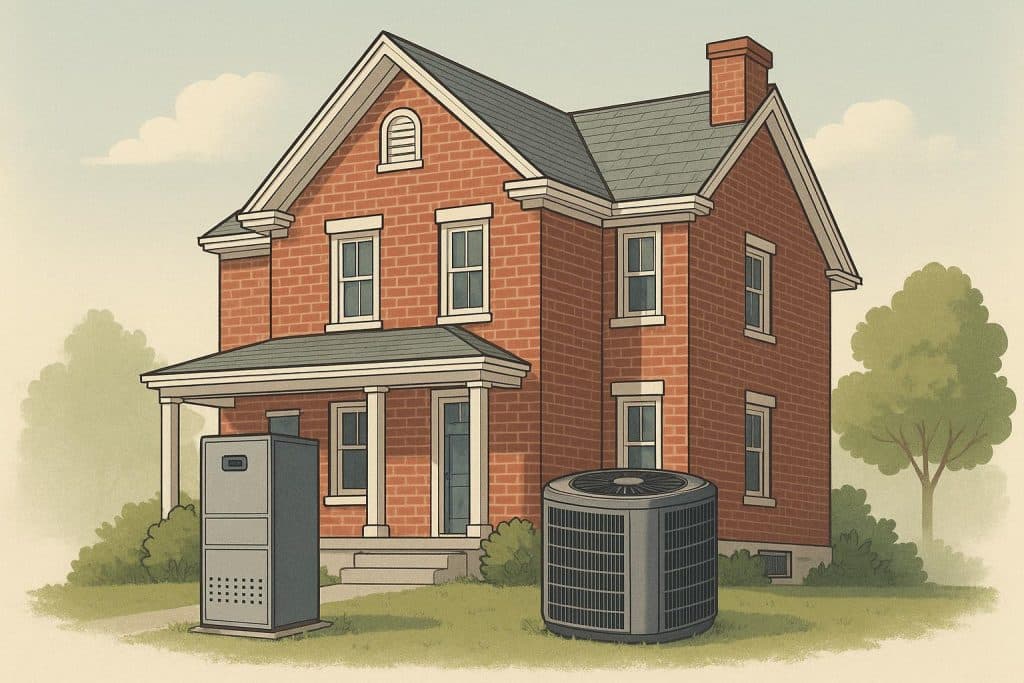Older homes carry charm, craftsmanship, and character that modern houses often lack. However, they also come with challenges—especially when it comes to maintaining comfortable indoor temperatures. Many older houses were not designed with modern heating and cooling systems in mind, leading to inefficiencies, uneven temperatures, and higher energy costs. Over time, outdated insulation, aging ductwork, and inefficient HVAC units can make comfort a struggle. We will explore practical and reliable heating and cooling service solutions tailored for older homes, helping homeowners enjoy modern comfort without compromising their home’s original beauty or structure.
Smart Ways to Improve Heating and Cooling Efficiency in Older Homes
- Assess and Upgrade Insulation and Sealing
The first step toward improving comfort in an older home is addressing insulation and air sealing. Many older homes were built before modern insulation standards were established, leaving their walls, attics, and crawl spaces vulnerable to energy loss. Inadequate insulation allows heated or cooled air to escape, forcing HVAC systems to work harder to maintain a comfortable indoor environment.
A professional assessment—such as the one offered about our HVAC company—can reveal areas that need improvement, such as unsealed windows, gaps in door frames, or thin insulation in attics. Adding spray foam, fiberglass batts, or blown-in insulation can significantly enhance energy efficiency. Weatherstripping doors and sealing window frames helps reduce drafts, keeping indoor temperatures stable. By focusing on insulation first, homeowners can reduce energy consumption and create a solid foundation for future heating and cooling upgrades.
- Upgrade Outdated HVAC Systems
Many older homes still operate on outdated heating or cooling units that were installed decades ago. These systems often use more energy and provide less comfort than today’s high-efficiency models. Replacing an old furnace, boiler, or air conditioner with a modern energy-efficient system can lead to significant savings over time. Homeowners should consider heat pumps, which offer both heating and cooling in one system and are particularly efficient in mild climates. Additionally, modern furnaces equipped with variable-speed motors and smart thermostats can automatically adjust to maintain consistent temperatures. Choosing the right system for an older home may also involve making modifications, such as upgrading the electrical capacity or adjusting the ductwork. These upgrades ensure the new unit operates at maximum efficiency while preserving the home’s existing architecture.
- Consider Ductless Mini-Split Systems
Ductless mini-split systems are an excellent solution for older homes that lack existing ductwork. Many historic houses were not designed with central air systems, and adding ducts can be expensive and invasive. Mini-splits eliminate that need by using individual air-handling units connected to an outdoor compressor. Each indoor unit can control the temperature of a specific room or zone, providing flexibility and energy savings. This zoning capability enables homeowners to heat or cool only occupied areas, thereby reducing unnecessary energy consumption. Additionally, mini-splits are quiet, efficient, and preserve the aesthetic integrity of older homes since installation requires minimal structural modifications. These systems can be particularly beneficial for homes with additions or converted attics where extending ductwork is impractical.
- Upgrade Windows and Ventilation Systems
Windows are one of the most common sources of energy loss in older homes. Single-pane windows, which were common in historic buildings, do little to retain heat or block external temperatures. Upgrading to double-pane or low-emissivity (Low-E) windows can make a dramatic difference in comfort and efficiency. For homeowners who wish to preserve original windows for aesthetic reasons, adding storm windows is an effective compromise. Ventilation also plays a critical role in maintaining indoor air quality and regulating temperature. Installing energy recovery ventilators (ERVs) or heat recovery ventilators (HRVs) can help circulate fresh air while minimizing energy waste. Proper ventilation prevents moisture buildup and enhances the performance of heating and cooling systems, ensuring that conditioned air flows evenly throughout the house.
- Integrate Smart Thermostats and Modern Controls
Technology has made it easier than ever to manage home comfort efficiently. Smart thermostats enable homeowners to remotely control heating and cooling and learn their household’s routines to adjust temperatures automatically. These devices can be particularly useful in older homes where heating and cooling zones vary. For example, if the upper floor tends to get warmer, a smart thermostat can regulate the system to maintain more even temperatures. Additionally, programmable thermostats can reduce energy consumption by adjusting temperatures when no one is home. Integrating these controls with modern HVAC systems enhances performance and offers better insight into energy consumption. The combination of smart technology and updated systems brings the convenience of modern living into the charm of an older home.
- Schedule Regular Maintenance and Tune-Ups
Even the most efficient system requires regular maintenance to perform at its peak. Older homes often present unique challenges—such as aging ductwork, outdated wiring, and older infrastructure—that can impact system performance. Regular heating and cooling service visits ensure that components are clean, lubricated, and functioning properly. Filters should be changed frequently to maintain air quality and airflow. Technicians can also identify potential issues early, such as leaks, loose connections, or worn-out parts. Routine maintenance not only prevents costly repairs but also extends the lifespan of heating and cooling systems. For older homes, consistent service ensures that both new and existing components continue to work harmoniously, maintaining comfort and reliability throughout the seasons.
Improving heating and cooling systems in older homes requires thoughtful planning, smart upgrades, and attention to detail. From enhancing insulation to installing ductless mini-splits and integrating smart thermostats, each improvement contributes to greater efficiency and comfort. Regular maintenance and attention to airflow ensure that these systems continue to perform optimally for years. While older homes may come with structural limitations, they also offer opportunities to blend tradition with modern innovation.
